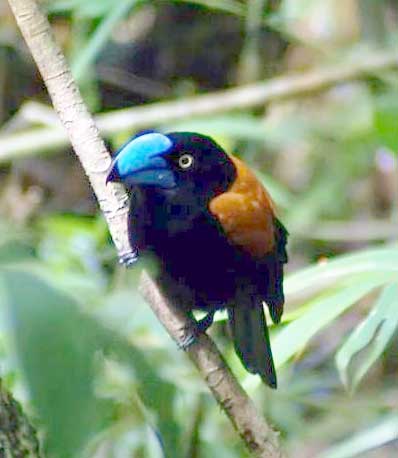Euryceros prevostii (*) Cladus: Eukaryota Name Euryceros prevostii Lesson, 1831 Vernacular names Reference Annales Des Sciences Naturelles 22 p.422 pl.12
The Helmet Vanga Euryceros prevostii is a distinctive-looking bird of the vanga family, Vangidae, and is classified in its own genus Euryceros. It is mainly blue-black in colour, with rufous wings and a huge arched blue bill. It is restricted to lowland and lower montane rainforests of northeastern Madagascar. Its diet is composed of invertebrates, predominantly insects. Taxonomy The Helmet Vanga is the only member of the genus Euryceros. Like most vangas it was originally placed in the shrike family Laniidae. When the ornithologist Austin L. Rand moved the majority of the vangas into a separate family in 1936, he placed Helmet Vanga in its own monotypic family, Eurycerotidae. It was moved to the vanga family by J. Dorst in 1960. The closest relative within the family is believed to be the Rufous Vanga, which is thought to have split from the Helmet Vanga 800,000 years ago.[2] The specific name prevostii commemorates the French artist Florent Prévost. Description Global distribution The Helmet Vanga is a large vanga, the second largest species of vanga after the Sickle-billed Vanga. In length it measures 28–31 cm (11–12 in) and weighs 84–114 g (3.0–4.0 oz). The most distinctive feature is the massive hooked bill, which is 51 mm (2.0 in) long and 30 mm (1.2 in) deep.[2] The plumage of the head, neck, throat, breast and belly are a solid blue-black, as are the primary coverts and remiges of the wing. The mantle, back, and the rest of the wings are rufous. The tail, which is long and broad, is black below and rufous above. The bill is bright blue with a black tip. Both sexes are alike.[2] Distribution and habitat It is restricted to lowland and lower montane rainforests in north-east Madagascar. Sites where it can be found include Marojejy National Park, the Masoala National Park and Mantadia National Park. Behaviour Adults mainly eat large insects, but food items brought to young in the nest may be more varied , including snails, lizards, spiders and crabs. Breeding
References 1. ^ BirdLife International (2004). Euryceros prevostii. 2006. IUCN Red List of Threatened Species. IUCN 2006. www.iucnredlist.org. Retrieved on 11 May 2006. Database entry includes justification for why this species is vulnerable
* Graetz, J. (1991) Nest observations of the Helmet Vanga Euryceros prevostii Newsletter of the Working Group on Madagascar Birds 1: 2. Source: Wikipedia, Wikispecies: All text is available under the terms of the GNU Free Documentation License |
|

